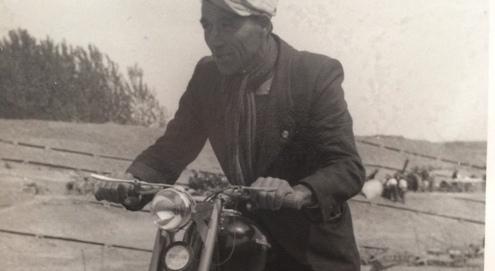Bella Ciao
Anonymous
| Original | 19b. 啊朋友再见 (Traduzione cinese letterale del canto partigiano) 19b. 啊朋友再见 (A ... |
| BELLA CIAO 1. La cosiddetta "Bella Ciao delle Mondine" di Vasco Scansani (1952) 1. The so-called "Riceweeders Version" of Bella Ciao by Vasco Scansani (1952)  Vasco Scansani. Tornando al “Canto delle Mondine”, Cesare Bermani ha dimostrato che Vasco Scansani, di Gualtieri (RE), mondino, marmista e pittore detto “Il Cachi” (fu anche amico del celebre pittore naïf Antonio Ligabue) lo aveva scritto, quando già “Bella Ciao” si era diffuso, riprendendone fedelmente la struttura e la melodia. Secondo il figlio di Vasco Scansani, Alfio, che conserva numerosi documenti del padre, la “versione delle mondine” sarebbe stata scritta nell'estate del 1952, mentre la famiglia Scansani si trovava al mare. Alla diffusione della leggenda del “canto originario delle mondine” avrebbe contribuito anche il fatto che a Gualtieri abitava anche Giovanna Daffini; non solo a Gualtieri, ma anche nello stesso stabile della famiglia Scansani, Palazzo Bentivoglio. Giovanna Daffini, la grande cantrice popolare, era, come è noto, proprio una mondina. Ciononostante, nella pagina manteniamo il primo posto a questo canto: un po' -oramai- per tradizione, e un po' perché il suo spostamento comporterebbe una ristrutturazione troppo ardua di questa enorme pagina. [RV]  Vasco Scansani. Returning to the “Bella Ciao of Riceweeders”, Cesare Bermani demonstrated that Vasco Scansani, from Gualtieri in the province of Reggio Emilia -a riceweeder, marble worker and painter nicknamed "Il Cachi" (he was also a friend of the famous naive painter Antonio Ligabue)- wrote it when the standard "Bella Ciao" had already spread, faithfully reproducing its structure and melody. According to Vasco Scansani's son Alfio, who keeps several of his father's documents, the "Riceweeders' version" was written in summer 1952, while the Scansani family was on seaside holiday. The fact that also Giovanna Daffini was then living in Gualtieri might have contributed to the spreading of the legend of the "original song”; not only Giovanna Daffini lived in Gualtieri, but also in the same building as the Scansani family's, Bentivoglio palace. Giovanna Daffini, the great popular singer, was a woman riceweeder. Nonetheless, we keep this song in first position in this page: just for tradition, why not, and also because its replacement would entail too difficult a restructuring of this huge page. [RV] {{video https://www.youtube.com/watch?v=gzYl5i1Ee7I}} Les Anarchistes: Tammurriata delle mondine including Bella Ciao {{video https://www.youtube.com/watch?v=v8pgt6scZ1g}} Interpretata da / Performed by Giovanna Marini. Alla mattina appena alzata, o bella ciao, bella ciao Bella ciao ciao ciao, alla mattina appena alzata, devo andare a lavorar..! A lavorare laggiù in risaia, o bella ciao, bella ciao Bella ciao ciao ciao! A lavorare laggiù in risaia Sotto il sol che picchia giù! E tra gli insetti e le zanzare, o bella ciao, bella ciao Bella ciao ciao ciao, e tra gli insetti e le zanzare, duro lavoro mi tocca far! Il capo in piedi col suo bastone, o bella ciao, bella ciao Bella ciao ciao ciao, il capo in piedi col suo bastone E noi curve a lavorar! Lavoro infame, per pochi soldi, o bella ciao bella ciao Bella ciao ciao ciao, lavoro infame per pochi soldi E la tua vita a consumar! Ma verrà il giorno che tutte quante o bella ciao, bella ciao Bella ciao ciao ciao, ma verrà il giorno che tutte quante Lavoreremo in libertà! | BELLA CIAO 一天早晨我醒来 啊你好,你好,你好 一天早晨我醒来 我发现了侵略者 啊朋友,带我离开 啊再见,再见,再见 啊朋友,带我离开 我感到像是要死去 如果我真的死了,朋友 啊再见,再见,再见 如果我真的死了,朋友 请将我埋葬 请将我埋葬在山上 啊再见,再见,再见 请将我埋葬在山上 在一朵美丽的花儿下 所有的人都会经过 啊再见,再见,再见 所有的人都会经过 对我说:“多美的花儿!” 这是一朵给朋友的花儿 啊再见,再见,再见 这是一朵给朋友的花儿 他为自由而死 这是一朵给朋友的花儿 他为自由而死 Yītiān zǎochén wǒ xǐng lái a nǐ hǎo, nǐ hǎo, nǐ hǎo yītiān zǎochén wǒ xǐng lái wǒ fāxiànle qīnlüè zhě a péngyǒu, dài wǒ líkāi a zàijiàn, zàijiàn, zàijiàn a péngyǒu, dài wǒ líkāi wǒ gǎndào xiàng shì yào sǐqù rúguǒ wǒ zhēn de sǐle, péngyǒu a zàijiàn, zàijiàn, zàijiàn rúguǒ wǒ zhēn de sǐle, péngyǒu qǐng jiāng wǒ máizàng qǐng jiāng wǒ máizàng zài shānshàng a zàijiàn, zàijiàn, zàijiàn qǐng jiāng wǒ máizàng zài shānshàng zài yī duǒ měilì de huā er xià suǒyǒu de rén dūhuì jīngguò a zàijiàn, zàijiàn, zàijiàn suǒyǒu de rén dūhuì jīngguò duì wǒ shuō:“Duō měide huā er!” Zhè shì yī duǒ gěi péngyǒu de huā er a zàijiàn, zàijiàn, zàijiàn zhè shì yī duǒ gěi péngyǒu de huā er tā wèi zìyóu ér sǐ zhè shì yī duǒ gěi péngyǒu de huā er tā wèi zìyóu ér sǐ |
